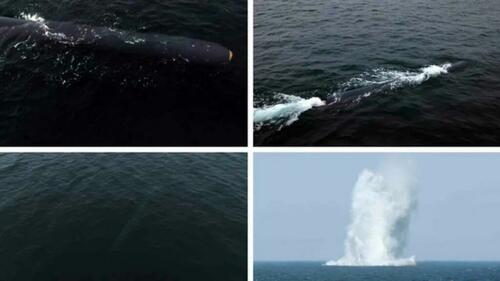North Korea Tests Exotic Underwater Nuclear Drone, Claims It Can Create “Radioactive Tsunami”
North Korea says it has tested a nuclear-capable underwater attack drone, which some analysts have dubbed an ‘exotic system’ given there’s not much known about it, in response to fresh naval exercises involving the United States off the peninsula. The testing of the “Haeil-5-23” system occurred of the country’s east coast.
Korean Central News Agency (KCNA) on Friday warned of “catastrophic consequences” for the US and its “followers”, also given the joint naval drills with South Korea also had Japan’s participation.

“Our army’s underwater nuke-based countering posture is being further rounded off, and its various maritime and underwater responsive actions will continue to deter the hostile military maneuvers of the navies of the US and its allies,” KCNA described.
While South Korean officials have in the recent past described that the north’s claims concerning the new weapon are exaggerated, it has gained the public’s attention given Pyongyang has touted the weapon’s ability for surprise attacks unleashing mass destruction by generating a “radioactive tsunami” through a large underwater explosion.
Reuters describes, “Dubbed ‘Haeil’, which means tsunami, the new drone system was first reportedly tested in March 2023, and state media said it was intended to make sneak attacks in enemy waters and destroy naval strike groups and major operational ports by creating a large radioactive wave through an underwater explosion.”

According to commentary on the mysterious weapon system as cited in Al Jazeera:
While there wasn’t much in the public domain about the drone tested, “what we do know about it, if it’s close to what they tested last year, is that this underwater unmanned vehicle is likely quite slow. It’s a very exotic system,” Mason Richey, a professor at the Hankuk University of Foreign Studies in Seoul, told Al Jazeera.
“It probably runs only something around eight knots per hour, which is somewhere around 14 or 15km [8.6-9.3 miles] per hour. It’s probably quite vulnerable to anti-submarine warfare.”
Its value was more likely “political signaling”, rather that its military use, Richey noted in light of the US, South Korean and Japanese drills.
“This does not make North Korea happy, and the political signal from this message here is quite clear – that it’s going to continue to develop its nuclear arsenal in this sort of … spiral situation that we find ourselves in now,” he added.
But as for Friday’s alleged test of the weapon, North Korea did not offer any proof that it actually worked, nor was there any sign of a tsunami in regional waters.
Much of the Kim Jong-Un government statement relayed via KCNA focused on denouncing the US-South Korea-Japan exercises. Pyongyang said it is “an act of seriously threatening the security” of the north, and that “The U.S., Japan and the Republic of Korea are getting frantic in their provocative military exercises.”
The statement added, “The armed forces of (North Korea) will strike horror into their hearts through responsible, prompt and bold exercise of its deterrent.”
The naval exercises in question included the aircraft carrier USS Carl Vinson and several warships, as well as the Japanese helicopter carrier JS Hyūga. Pyongyang is especially angry that the US has docked a nuclear submarine in the south several times since last summer.
Tyler Durden
Fri, 01/19/2024 – 13:45
via ZeroHedge News https://ift.tt/MznbfRB Tyler Durden
